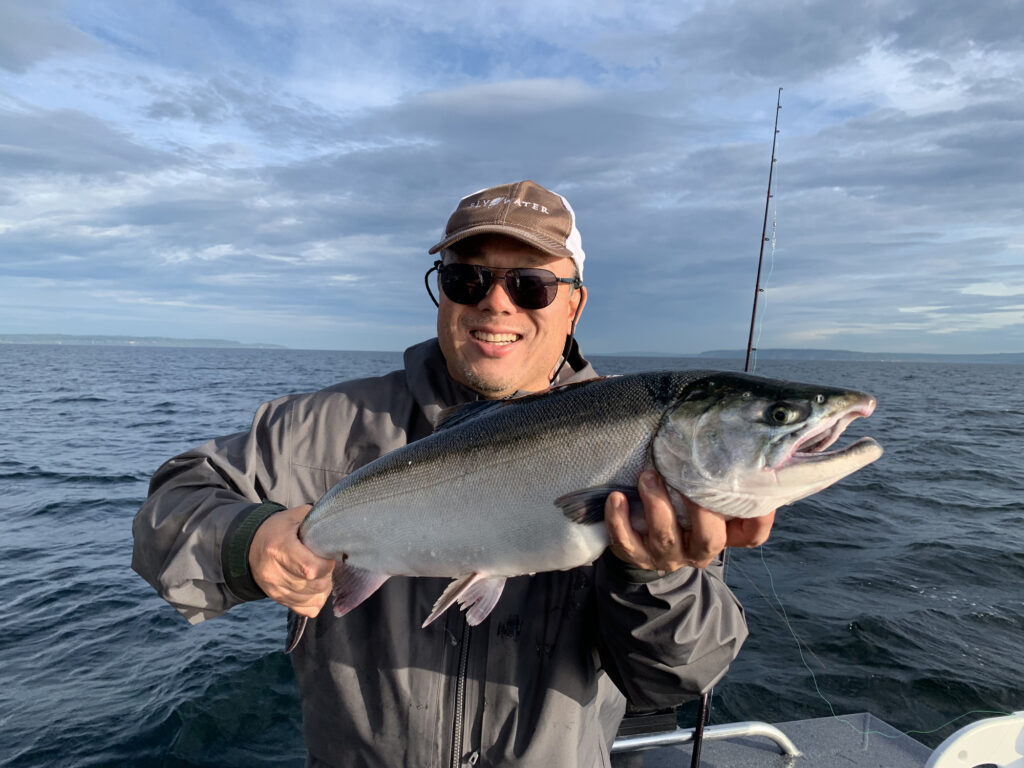
Spring is just a few weeks away and there are several activities to put on the “must do” list before the season official kicks off. First up on that list: Keep tabs on how the upcoming salmon season is setting up.
Salmon Set-Up
Early indications show that the 2023 salmon forecasts could mirror what anglers saw in 2022 fisheries. In fact, preliminary forecasts show some fish returns could be somewhat better if the “crystal ball” of forecasts align with actual fish returns.
In February, the Oregon Production Index—which provides ocean coho abundance forecasts—revealed an estimated 1,135,700 coho are set to arrive off the Washington coast. That is down a tad from a forecast of 1,225,900 and an actual return of 887,500 in 2022. The Columbia River subtotal forecast is 886,100 coho compared to 997,200 in 2022 and an actual return of 685,200. While the actual coho forecast is down, state fishery managers in the past have noted an actual return of around 700,000 that should offer good summer fishing off Neah Bay, La Push, Westport, and Ilwaco, and in the Columbia River and its tributaries.
Since this is an odd-numbered year, inner-marine areas should also see a relatively decent forecast of pink salmon that return every other year to Puget Sound rivers and streams.
Coho, pink and other salmon forecasts will be announced by the Washington Department of Fish and Wildlife (WDFW) during a public meeting on Friday, March 3 at the Lacey Community Center in Lacey. The meeting is part of the month-long season setting process known as North of Falcon, a term referring to waters north of Oregon’s Cape Falcon, which marks the southern border of management of Washington’s salmon stocks. This includes Puget Sound, Strait of Juan de Fuca, Columbia River, and coastal Washington salmon stocks.
State fishery managers use a suite of scientific data—including watershed sampling and monitoring, ocean indicators, and previous year returns—to estimate the number of salmon returning and decipher how many fish are available to catch.
Other salmon forecasts include a good return of 307,800 Columbia River spring Chinook. That compares to 197,000 forecast and actual return of 274,495 in 2022. The lower Columbia River tributary returns of spring Chinook on the Washington and Oregon side also look promising.
The Upper Columbia summer Chinook forecast of 84,800 is up from a 2022 forecast of 56,300 and an actual return of 78,444. This run is the main driver for recreational fisheries from the Rocky Reach Dam to Chelan Falls as well as many other open areas further upstream and downstream.
The Columbia sockeye forecast is a modest 234,500 in 2023. In 2022, the forecast was 198,700 and the actual return hit a robust 664,935, which was the largest since Bonneville Dam was erected in 1938.
The Pacific Fishery Management Council meeting on March 5-10 in Seattle is where ocean salmon season options are proposed for waters three to 200 miles off the coast. All West Coast salmon fishing seasons and harvest levels will be finalized on April 2-7 at meetings in Foster City, CA. For a meeting schedule with opportunities to participate in meetings and provide public feedback, visit WDFW’s public meeting pages at: wdfw.wa.gov/fishing/management/north-falcon/public-meetings.
Other Opportunities
Here are two more fisheries to add to your agenda. After a three-months pause, the coastal razor clam season at Copalis and Mocrocks beaches recently reopened, although before heading out be sure to check the WDFW website for any last-minute changes or emergency closures.
Razor clams are a highly sought-after shellfish along Washington’s coast, and it isn’t unusual to have as many as 1,000 diggers per mile scouring the beaches on a nice weekend day. Razor clam digging is an enjoyable activity for all ages, and it doesn’t take a lot of high-tech gear. All you need is a clam gun or shovel, a mesh net to put your clams in, a headlamp and lantern, warm clothes, rubber boots and a shellfish license.
WDFW plans to announce future digging opportunities in March when marine toxin tests show it is safe to do so. For additional details, go to the WDFW’s razor clam webpage: wdfw.wa.gov/fishing/shellfishing-regulations/razor-clams. Also mark your calendars for The Ocean Shores Razor Clam and Seafood Festival this month March 17-19 at the Ocean Shores Convention Center (more at: chamber.graysharbor.org) and the World Class Crab Races, Crab Feed & Crab Derby and Clam Derby takes place next month April 15-16 in Westport (details can be found at: graysharborbeaches.com/south-beaches-annual-events.html).
Last, but certainly not least, the hatchery Chinook salmon fishery at Sekiu in the western Strait of Juan de Fuca (Marine Area 5) reopens on March 1 through April 30, but could close sooner if catch guidelines are achieved. Prior to this month’s magazine deadline, central Puget Sound (Marine Area 10) was scheduled to be open daily for hatchery Chinook salmon through March 31 but could close sooner if catch guidelines are achieved. Southern Puget Sound (Marine Area 13) south of the Tacoma Narrows Bridge is open year-round for hatchery Chinook salmon.


